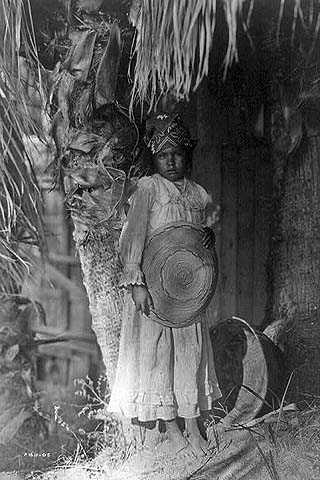Religion - World View
The Cahuilla believed that they lived in a systematic, but unpredictable, universe,
in which one could maintain existence only by being able to access and use "?iva?a," or power, which
was also unpredictable, and potentially dangerous. They accordingly were constantly in a state of
apprehension about the future, an attitude that was realistic in the desert
environment
of their
homeland (Bean 1972:161-164).
They believed that "?iva?a," was differentially distributed, a fact that explained unusual
talents or abilities, and unexpected events. It was possessed by both animate and inanimate
beings, any of whom could use it for both negative and positive actions. They believed also
that human beings and other parts of the universe made up an interacting system, a belief that
fostered an
ecological
ethic (1972:163-165).
According to Cahuilla tradition, each individual had a tewlavelem, or soul spirit, that
persisted after his or her death in temelkis, the land of the dead, where all the tewlavelem
and the nukatem (people from Creation Time) lived, and which was located somewhere to the east. It
could usually be reached only after an arduous ritual in which both the telmekis and the living
survivors of the deceased participated. Once there, the tewlavelem could still hold some
communication with the living, sending them advice and help (1972:168-169).
The Cahuilla creator gods were twin brothers, Mukat and Temayawet, who fought over who was the
older, in keeping with Cahuilla respect for the aged, a useful adaptation in a difficult environment
since it encouraged younger people to draw on the wisdom of their elders in threatening situations. Mukat,
who worked slowly and carefully at the task of creation, and who promoted caution, precision, and
orderliness in the face of challenge, won out over his brother, who "worked rapidly and
injudicially" (1972:171). The latter departed for the underworld. Unfortunately, Mukat was not
consistently benign. He taught his people how to live, but tended on occasion to give them bad
advice in a spirit of trickery. He also violated Menily (moon maiden), who gave people additional
advice on how to live. His people for these reasons magically killed him, and as he lay dying, he
gave instructions for his cremation. Despite precautions, Coyote managed to steal Mukat's heart
from his burning corpse and to run with it into the desert, where it left red pigment where it was
put down. The story of the cremation is sung at Cahuilla nukil ceremonies, sung ceremonially every
year or two in memory of those who have died since the last nukil. These were the Cahuilla's most
sacred ceremonies (1972).

A Cahuilla girl